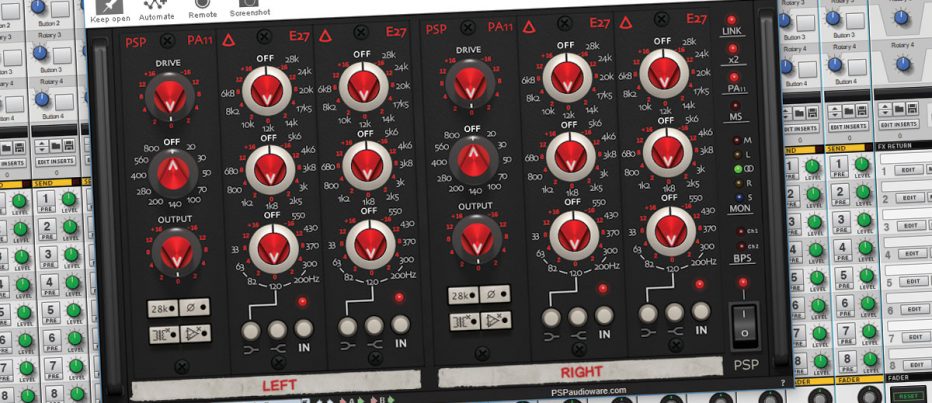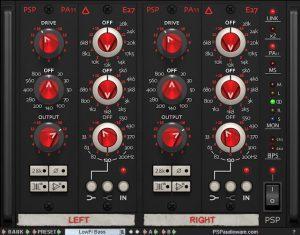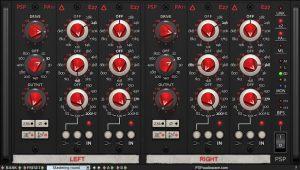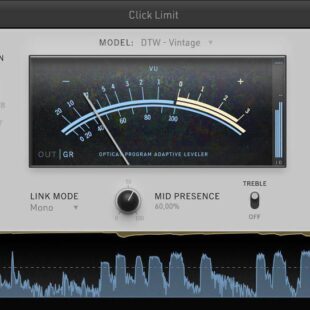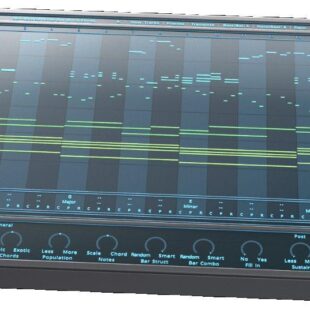PSP Audioware E27 Equalizer – Crossing the Line
Hello and welcome to Music Nation. This week we’re featuring a rather interesting equaliser plugin by Polish developer PSP Audioware, the same guys who brought us the brilliant Nexcellence reverb plugin last year. This time we’re looking at their detailed emulation of Avedis Audio’s E27 hardware equivalent, and whether the line between analogue and digital has truly been removed.
(Review updated February 2021) I love reviewing PSP Audioware titles because so far everyone has been sensational. An equaliser plugin is always going to be challenging to review due to the nature of the device which needs to be as transparent as possible. However, the intriguing design and hardware background certainly have perked my interest. So let’s get PSP E27 installed and see what all the fuss is about.
Overview
PSP E27 and the included E27se variant are dual channel equalisers with a built-in pre-amp module modelled off the original EuroRack hardware unit directly in conjunction with Avedis Audio Electronics.
Right off the bat, it’s great to know that both software and hardware developers have worked together to ensure the product is as authentic as possible. The EQ module features three or six bands of fully parametric non-linear control in either mono, stereo or full M/S mode. You can engage the extra PA11 pre-amp option to add a hi-pass filter, drive boost or cut, amplitude control, phase inversion, plus a nifty 28k boost button for a little more air at the input stage. You can also choose to bypass the pre-amp drive transformer modelling totally and just use the module for the hi-pass filter.
Roadtest
The slick GUI is directly modelled from the EuroRack hardware unit, unfortunately, including the frustratingly tricky inverted controls. Not only is everything upside down, but the mouse operation is traditional in operation – so sweeping up reduces input, and pulling down increases.
Also, though the GUI looks great, I found the multifunctional stacked rings on the EQ controls quite annoying to operate since the UI doesn’t scale, and on our high-resolution monitor, the dials are quite tiny and difficult to grab precisely. There is no readout showing what frequency or amplitude you’re affecting and it can be difficult to read the tiny lettering on your screen. Also, as with the original hardware, there are no indicators, so input and output gain is largely guesswork.
On hardware, small dials aren’t so much of a problem as you tend to dial in changes more by ear than by precise measurements. The EuroRack 500 devices are designed to be as compact and as space efficient as possible, but I don’t think that degree of emulation needed to be carried over into the software. We have much larger screen real estate and can forgive a little design creativity in favour of better ergonomics.
The E27 is a stepped frequency filter with sweepable amplitude, my favourite analogue console from many years ago had such a design and I love the feel of the EQ section.
It can be hard to see precisely where the amplitude dial is pointing, as the red-on-black font type is quite hard to read. The outer white frequency dials are slightly easier to see as there is a black line indicating the frequency you’re targeting, which also glows a little brighter as you select it. You can actually just click on the frequency to select it, which is much easier than turning the dial and dealing with the whole upside-down and backward mouse controls. Overall the UI just feels messy and constricted.
Included is a small collection of presets, though nice, I would have liked to have seen more than the 15 or so provided.
The Sound
Interface gripes aside, the most important factor is definitely the sonic capabilities. There are only three bands on the device, so it’s easy to discuss each in detail.
The top-end filter ranges from 6k to a whopping 28k. This is the single control that adds ‘expense’ to your mix, and the E27 without a doubt has that beautiful and delicate airiness I look for on a console, without ever sizzling or breaking up, even with extreme boosts.
I’m impressed that I can still hear the 28k range, though it’s more ‘air’ than any definable tone. My favourite 10k notch is present and sounds wonderful. I literally add 10k to everything, it’s my “go-to” frequency for opening up the sound and clearing out the fluff in your mix, especially on multi-mic instruments like drums.
Moving down to the mid-range 680 to 5k dial, this is where the body of the mix lives and the easiest filter to get totally wrong. Thanks to E27’s non-linear curves it is much more forgiving with higher boosts. Non-linear curves work like a rubber band, as you push a frequency band higher the width gets tighter, so at full boost you end up with a very small Q-width. I find this makes honing in on problematic frequencies much easier since there is very little crossover into other frequencies as you boost.
The low end 33 to 550hz is unusual to anyone not familiar with a full non-linear parametric EQ. It’s wonderful to have such freedom down low to get some really detailed filtering done. E27 has a fantastic low-to-sub-low region for me. Since non-linear curves aren’t boosting all the other garbage around you can get extremely tight low-end control. You only have three or four frequencies to choose from down here, but you can really focus tight on each one if you need to.
The mid/side processing option is a feature PSP Audioware put to good use in many of their plugins, E27 is no exception. M/S mode is for splitting the incoming stereo signal into two distinct ‘middle’ and ‘side’ sections. The Middle section contains only bass signals converted to mono, whereas the side signal contains only the high-range full-stereo frequencies. This makes focusing EQ on either bass or high-range frequencies much easier than dealing with the traditional full-range signal, particularly ideal for working on very wide sources like reverb, synthesisers and drum overheads.
Finally, the PA11 section’s drive control is a subtle but nice touch. Driving the input gain before the main filter changes the overall character of the EQ, so it takes a little practice to get the feel of it. The drive is super-subtle though, don’t expect crazy saturated and nasty results, this is warmer than a destructor. The additional 28k boost button adds the lovely, stratospheric high-end icing sugar to the signal, again before the main filter, so you effectively double-dip your 28k boost here, which might lead to some interesting results.
CPU performance was better than expected, pushing only 2-4% on our test rig per instance. This is heavier than your stock DAW EQ, of course, but there is a lot more processing and features at work, so an acceptable power usage.
Conclusion
A wonderfully simple and effective EQ made somewhat clumsy by its steadfast replication of the original hardware device. The workflow will become second nature in time, just expect some frustration as you familiarize yourself with the device.
The device has some unique filter bands and on the whole a very open and clean sound. I found no digital artefacts or distortion, even when pushed to extreme levels. I was cautious at first about using the 28k boost button too liberally, but now I tend to start with the boost engaged in all instances by default.
E27 is a wonderful addition to the catalogue and a great-sounding EQ well worth adding to your (hopefully) growing collection of PSP Audioware products.
There is a 30-day full feature trial available, so download and listen for yourself.
Full details are on the official PSP Audioware website www.pspaudioware.com. For information on Avedis Audio’s hardware equivalent, check out their site www.avedisaudio.com
Like the review? Shout us a cup of coffee!

